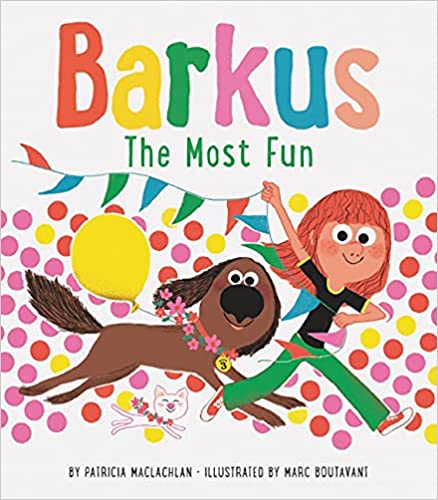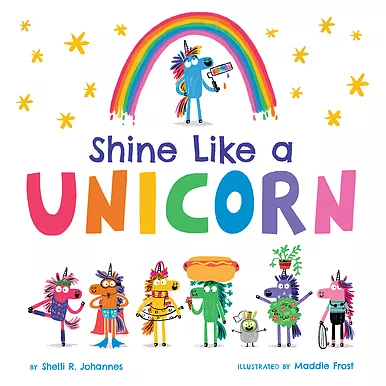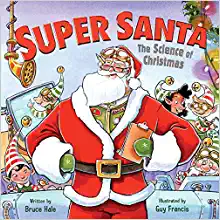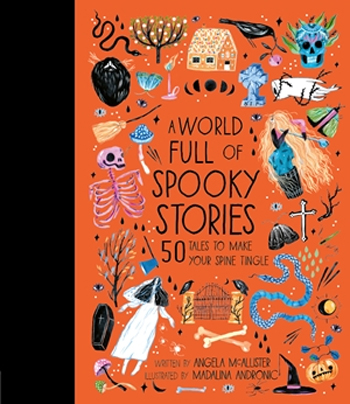
It's happened. The fourth quarter. The changing of the weather. The holiday season. Or, as I call it, “give up any ideas about dieting” season. Yes, October has come, and with it a time to start planning our festive activities. Candy-filled Halloween parties, turkey with family and friends, and Christmas cookies are the norm in these last few months of the year, and I enjoy it all. But I also enjoy complementing all the food with fun seasonal books. We've included three of our favorite new holiday titles in this month's newsletter, along with our other all-occasion reviews. Ones that are great additions to a home, public, and school library collection. So, grab your favorite candy bar and get started reading early before these new books are all checked out.
Happy Halloween,
Shelley Oakley
Director, Children's Literature
Subscribe to ChildrensLit Now Newsletter
In case, if you have missed our previous issue.

Children love bright objects and images, especially as they begin learning the vocabulary that describes their world. The "My World in 100 Words" collection introduces young children to concepts and ideas by placing choice vocabulary against dynamic backdrops. In this book, readers are transported to the beauty of fall and the anticipation of the Halloween holiday. From picking pumpkins and carving them to dressing up and enjoying treats on Halloween night, children and families will recognize familiar moments in the colorful illustrations. Additionally, a sparkly cover provides an intriguing textural enhancement to the book for small hands to explore. Though there is no formal narrative in these books, the images provide a logical progression of actions from beginning to end. As adults read these books with their children, then, they can easily use the illustrations to create their own accompanying stories while modifying and enhancing the details as their children grow. One hundred words are included in each of these books, and while the vast majority are nouns, action words and feeling words are included in each scene, as well. Children will learn vocabulary that not only describes the world they see and experience but also the words to describe what they are doing and how they are feeling at the same time. The illustrations are richly colored, using clean lines and deep hues to bring life to the pages of this book. A variety of human backgrounds and abilities are depicted in the images, and readers will enjoy recognizing themselves and others they know in each story. This board book series is an informative and visually appealing addition to collections for very young children.

This is not a book one can read in a day, but rather one that should be digested bit by bit. On the premise that all of the talk about climate change can be scary for young people, this book includes coping mechanisms. But it also has good discussions about the various aspects of our changing climate, both worldwide and locally. Grown-ups have a hard enough time not stressing about the changes, but children probably feel even more helpless about the situation. A lengthy introduction outlines various topics related to climate change. The first chapter, "How We Know What We Know," starts with a reminder that though the reader may not have experienced a stressful climate-related phenomenon such as a hurricane or tornado, such things are real and will become more frequent if we don't correct the way we've damaged the planet. The discussion of what science tells us is succinct and interesting. Chapters two through five discuss in more detail issues like earth's heating up, how everything is connected, practicing "eco-justice," and making a healthier world together. Brief bios of influential young people such as Greta Thunberg are sprinkled throughout the book. There are helpful sections for caregivers and counselors, finishing with a list of climate-aware therapists, plus a glossary and a bibliography. If nothing else, the book might spark a greater feeling of commitment by young people.

Phoebe and her ten-year-old sister Okalee have a relationship like many sisters do. They are fiercely protective, constantly jealous, and competitive in everything. Phoebe accepts responsibility for her little sister, even though she has never been told that she is supposed to be the responsible one. Phoebe's highest dream at this age is to sing the solo in her school's musical production. Kat has won the role for the past few years, but Phoebe is sure that this year it is hers. Okalee, as she sits on the front row of the gymnasium, is also sure that this is Phoebe's year. On the way home from tryouts, the sisters decide to celebrate. Each year, on the first day that it is apparent that Spring is on its way, they have a secret celebration they call River Day. The sisters hold hands and cross the cold, churning river together to win the challenge. No one knows about their challenge except the two of them. That will turn out to be a mistake, and it will teach Phoebe some lessons about loyalty, family, and secrets. Author Melchor will lead readers to an understanding of family relationships, missed opportunities, and the drama that many middle school students deal with every day.

Meet Barkus, a delightful pup whose owner declares him to be the "smartest dog in the whole world!" Although Barkus does not talk for himself, the first-person narrator, a young girl, clues us in to what he likes and what he thinks. This third book in the popular new series finds Barkus and family undertaking several enjoyable outings: camping, to visit the grandparents' farm, attending an autumn parade, and taking a winter trip to their cabin. The fun is multiplied by the addition of a feline friend. Family kitten Baby has decided to tag along on each of these adventures, and although there are concerns she might not like camping, or the water, and so on, none of these are a problem. In each of the four short stories in this book, our narrator seems certain that all will be well—and it is. This is a wonderfully reassuring book, with four short stories that each contain some happy surprises. Budding readers will feel confident building their language skills with this charming, happy-looking book. Other books in the series include Barkus and Barkus: Dog Dreams. Readers will be hoping for additional Barkus adventures in the future. Recommended for early reading classrooms, public libraries, and home collections.

A beautiful guide to Christmas traditions around the world, as well as deeper explanation of Advent, Saint Nicholas's Day and other Christmas traditions. Utnik-Strugala focuses on traditions; she deftly avoids the temptation to divide her material by individual countries. The illustrations are absolutely lovely, and the beautiful red cover helps to usher in the spirit of Christmas. This is a wonderful classroom guide for any teacher that celebrates Christmas traditions with their students since it presents many different ways to celebrate this holiday! Use this book as a guide but also a way to get your students thinking about all aspects of Christmas, from who actually delivers the presents to what we do the day before to the Christmas day and more. Bonus content includes New Year's Day and Three Kings Day, which add an additional, much-needed angle to the discussion of celebrating Christmas.

Previous novels by this author have addressed horrific incidents, including child abuse, murder, poverty, and sexual exploitation. This is Jackson's first official horror story, and it is filled with seemingly supernatural occurrences and a family desperately trying to start over. At the story's start, protagonist Mari is moving with her younger brother, younger stepsister, stepfather, mother, and family dog from California to Cedarville, a small Midwestern town. Mari's mother, a writer, has been awarded a fellowship granting them free housing for a year, which is officially the reason for the family's move. Unofficially, the family is recovering from painful trauma and looking for a new beginning. Readers find out that Mari is a drug addict with obsessive-compulsive disorder, seeing things even when they're not there. Of course, to her family, this makes her unreliable and unbelievable as she tries to explain the mysterious incidents she encounters. In many ways, however, the main character is actually the house Mari and her family move into. Things disappear, doors close on their own, electricity flickers, and shadows appear, making Mari uneasy and uncomfortable in her new home. Fans of horror will recognize many of the devices Jackson uses—unexplained sounds, a haunted basement, a possessed child—but that doesn't mean they aren't frightening. Jackson is also the master of acknowledging the horror that society wreaks; in this book, the horrors stem not just from Mari's haunted house but from Cedarville's violent past, gentrification, and profiteering from the prison industrial complex. This novel is a blend of contemporary social issues as well as timeless horror tropes that will appeal to many readers.

From the start, this colorful book engages readers' imaginations, asking if they'd like to be a unicorn. Then, it goes through a series of silly steps for how to become one. This part of the story is both interesting and silly enough to keep the attention of any child. Still, the best part is the second half of the book. During the steps, the unicorn encourages the reader to be themselves and unique. It also talks about not being perfect, owning our mistakes, and learning to share. The lessons in this book are inspiring and relatable. The last few pages talk about step nine, assuring readers that it will be enticing and fun for the reader. The final step is the best yet, as it fully encourages the reader to be themselves and make their own magic. This is a book about learning and realizing each person's value is as special as a unicorn.

What could be more fun than studying the science behind Christmas? In this charming story, young readers travel to the North Pole, where they take a peek behind the scenes of Santa's workshop on Christmas Eve. During the year, the elves make over a billion presents, which is only possible because Santa had the foresight to design his workshop efficiently. Santa's toboggan travels over 20 million miles in one night and holds more than a million tons of presents. The sled is designed to come to a halt when it reaches a rooftop so that Santa can safely deliver presents. Santa wears a red suit that protects him from the heat and pressure of high-speed travel. This year, by the time Santa is ready to fly out, he is already half an hour late. Can he make up this time, or will some children end up with empty stockings on Christmas Day? By the end of this charming story, children will have a far better appreciation for Santa Claus and the spirit of the Christmas holiday. With humorous text and beautiful pictures, young readers are taken on an exciting journey into the world of Christmas, where engineering and magic make all things possible.
Mary Lanni

Mary Lanni has been a prolific Children's Literature reviewer since 2015. She has worked in the education field since 2011, beginning in the Children's Museum and transitioning to the Denver Public Library in 2012. Mary earned her MLIS in 2015 and served on the Colorado Libraries for Early Literacy Steering Committee from 2015-2018. She enjoys picture books and middle grade books. "There's been a huge push for great books, especially those by #ownvoices authors, and I love seeing the plethora of options for young people to enjoy." When not reviewing, Mary likes to crochet, read, and spend time with her family.
The Aesop Prize
The Aesop Prize recognizes exceptional folklore-based books for children and young adults. Each book that wins the award or receives the Aesop Accolade (honor books) must accurately represent the folklore story in both text and illustrations. In addition, the winner and accolades should also help the reader understand the folklore and can be fiction or nonfiction. This book award is sponsored by the Children's Folklore Section of the American Folklore Society. For more information about eligibility requirements, visit https://childrensfolklore.org/aesop-prize/.
2020 Aesop Prize
The Fabled Life of Aesop by Ian Lendler and illustrated by Pamela Zagarenski

The Tortoise and the Hare. The Boy Who Cried Wolf. The Fox and the Crow. Each of Aesop's stories has a lesson to tell, but Aesop's life story is perhaps the most inspiring tale of them all. Honoring the path of a slave, this dramatic picture book biography and concise anthology of Aesop's most child-friendly fables tells how a child born into slavery in ancient Greece found a way to speak out against injustice by using the skill and wit of his storytelling- storytelling that has survived for 2,500 years. Includes thirteen Aesop fables.
2020 Aesop Accolades
Under the Cottonwood Tree: El Susto de la Curandera by Paul and Carlos Meyer and illustrated by Margaret Hardy

It's 1949, and the sleepy little village of Algodones, New Mexico, is about to be awoken by a strange magic. An enchanted cookie transforms Carlos Lucero from a boy into a black and white calf, and it's up to his older brother Amadeo to find a way to change him back.
2020 Aesop Accolades
Lola: A Ghost Story by J. Torres and illustrated by Elbert Or

Jesse didn't really know his Lola (the Tagalog word for grandmother), but he remembers that she tried to drown him as a baby. Strange stories surround Lola: she had visions, she fought off monsters straight out of Filipino folklore, and, according to some, she may have even seen ghosts. Now Jesse is struggling with the same visions Lola had, but Lola's not around anymore, and the rest of his family are too tied up in their own personal demons to help. Personal demons that Lola might have helped with if she were still alive. As Jesse explores his new abilities, he realizes that he might be the one who needs to step into that role—and that helping others might just help him, too.
2020 Aesop Accolades
The Moose of Ewenki by Gerelchimeg Blackcrane and illustrated by Jiu Er. Translated by Helen Mixter

When a Mongolian elder named Gree Shrek hunts a female moose by mistake, her young calf is left behind. Saddened by her loss, Gree Shrek names the calf Xiao Han ("Little Moose"), and the moose and man form an authentic attachment. Xiao Han accompanies Gree Shrek as the hunter-gatherer herds reindeer, sets up camp, forages for food in the forest, and visits his peoples' village, where many fun adventures happen. But as the little moose grows bigger, Gree Shrek knows he must return his companion to the forest. This story illuminates the traditional and vanishing way of life for the Ewenki peoples of Inner Mongolia.
2020 Aesop Accolades
A World of Spooky Stories: 50 Tales to Make your Spine Tingle by Angela McAllister and illustrated by Madalina Andronic

Feel your pulse race and your skin tingle as you turn the pages of this spine-chilling anthology of spooky stories from around the world. Read all about the fearsome witch Baba Yaga, the serpent woman from Spain, the rescue of Tam Lin from the bewitching Queen of the Fairies, how Father Death gets caught in the Enchanted Apple Tree, and the water-dwelling Bunyip from Australia. Make sure you have your candle ready, as it's sure to be a long night. Features stories from Germany, Czechoslovakia, Russia, Africa, Brazil, Japan, Australia, India, UK, Canada, France, China, Ireland, Syria, Korea, Sweden, Egypt, Iceland, New Zealand, Arabia, Spain, Tibet, Iran, Greece.
★ Are you an author or illustrator looking for more ways to speak at libraries and schools? Then you'll want to sign up for Children's Literature's newly updated Booking Service. Our updated Booking Service program allows event coordinators to find a variety of authors and illustrators for events and school visits, in-person or virtually, regardless of specific publisher representation. All with no fee-per-event from Children's Literature for the author/illustrator or the event coordinator. Your yearly subscription is all it takes to participate. Learn more at https://tinyurl.com/3wb8mwtm.